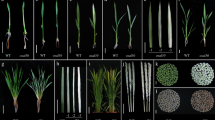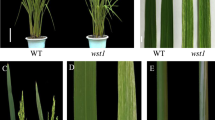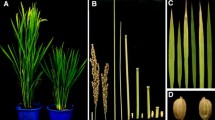Abstract
The glabrous leaf and hull (gl1) mutants were isolated from M2 generation of indica cultivar 93-11. These mutants produced smooth leaves and hairless glumes under normal growth conditions. By analyzing through scanning electron microscope, it was revealed that the leaf trichomes, including macro and micro hairs, were deficient in these mutants. Genetic analysis indicated that the mutation was controlled by a single recessive gene. Using nine SSR markers and one InDel marker, the gl1 gene was mapped between RM1200 and RM2010 at the short arm of chromosome 5, which was consistent with the mapping of gl1 in previous studies. To facilitate the map-based cloning of the gl1 gene, 12 new InDel markers were developed. A high-resolution genetic and physical map was constructed by using 1,396 mutant individuals of F2 mapping population. Finally, the gl1 was fine mapped in 54-kb region containing 10 annotated genes. Cloning and sequencing of the target region from four gl1 mutants (gl1-1, gl1-2, gl1-3 and gl1-4) and four glabrous rice varieties (Jackson, Jefferson, Katy and Lemont) all showed that the same single point mutation (A→T) occurred in the 5′-untranslated region (UTR) of the locus Os05g0118900 (corresponding to the 3′-UTR of STAR2). RT-PCR analysis of the locus Os05g0118900 revealed that its mRNA expression level was normal in gl1 mutant. RNA secondary structure prediction showed that the single point mutation resulted in a striking RNA conformational change. These results suggest that the single point mutation is most likely responsible for the glabrous leaf and hull phenotypes in rice.







Similar content being viewed by others
References
Allamand V, Richard P, Lescure A, Ledeuil C, Desjardin D, Petit N, Gartioux C, Ferreiro A, Krol A, Pellegrini N, Urtizberea JA, Guicheney P (2006) A single homozygous point mutation in a 3′-untranslated region motif of selenoprotein N mRNA causes SEPN1-related myopathy. EMBO Rep 7:450–454
Bird D, Beisson F, Brigham A, Shin J, Greer S, Jetter R, Kunst L, Wu X, Yephremov A, Samuels L (2007) Characterization of Arabidopsis ABCG11/WBC11, an ATP binding cassette (ABC) transporter that is required for cuticular lipid secretion. Plant J 52:485–498
Causse MA, Fulton TM, Cho YG, Ahn SN, Chunwongse J, Wu K, Xiao J, Yu Z, Ronald PC, Harrington SE, Second G, McCouch SR, Tanksley SD (1994) Saturated molecular map of the rice genome based on an interspecific backcross population. Genetics 138:1251–1274
Day IS, Miller C, Golovkin M, Reddy AS (2000) Interaction of a kinesin-like calmodulin-binding protein with a protein kinase. J Biol Chem 275:13737–13745
Duvel K, Braus GH, Egli CM (1999) A single point mutation in the yeast TRP4 gene affects efficiency of mRNA 3′ end processing and alters selection of the poly(A) site. Nucl Acids Res 27:1289–1295
Guo L, Luo L, Zhong D, Yu X, Mei H, Wang Y, Ying C (1999) Evaluation, improvement and utilization on some selected American rice cultivars. J Zhejiang Agric Sci 5:201–206
Hansen JD, Pyee J, Xia Y, Wen TJ, Robertson DS, Kolattukudy PE, Nikolau BJ, Schnable PS (1997) The glossy1 locus of maize and an epidermis-specific cDNA from Klenia odora define a class of receptor-like proteins required for the normal accumulation of cuticular waxes. Plant Physiol 113:1091–1100
Hu P, Tang S, Luo J, Huang F (1999) Utilization of American glabrous rice and breeding of super-high-yielding varieties. Acta Agron Sin 25:32–38
Huang CF, Yamaji N, Mitani N, Yano M, Nagamura Y, Ma JF (2009) A bacterial-type ABC transporter is involved in aluminum tolerance in rice. Plant Cell 21:655–667
Hülskamp M (2004) Plant trichomes: a model for cell differentiation. Nat Rev Mol Cell Biol 5:471–480
IRGSP (2005) The map-based sequence of the rice genome. Nature 436:793–800
Johnson HB (1975) Plant pubescence: an ecological perspective. Bot Rev 41:233–258
Kobayashi K, Ishikawa R, Senda M, Akada S, Harada T, Niizeki M (1997) Six glabrous phenotypes of rice classified with a scanning electron microscope. Rice Genet Newsl 14:53–54
Lander ES, Green P, Abrahamson J, Barlow A, Daly MJ, Lincoln SE, Newburg L (1987) MAPMAKER: an interactive computer package for constructing primary genetic linkage maps of experimental and natural populations. Genomics 1:174–181
Larsen PB, Geisler MJB, Jones CA, Williams KM, Cancel JD (2005) ALS3 encodes a phloem-localized ABC transporter-like protein that is required for aluminum tolerance in Arabidopsis. Plant J 41:353–363
Levin DA (1973) The role of trichomes in plant defense. Q Rev Biol 48:3–15
Liu R, Meng J (2003) MapDraw: a Microsoft Excel Macro for drawing genetic linkage maps based on given genetic linkage data. Hereditas (Beijing) 25:317–321
Liu W, Zhang J, Luo W, Lin Q, Chi X, Cai W (2005) Progress in breeding of nude hybrid rice. Hybrid Rice 20:6–10
Lu L, Lee YR, Pan R, Maloof JN, Liu B (2005) An internal motor kinesin is associated with the Golgi apparatus and plays a role in trichome morphogenesis in Arabidopsis. Mol Biol Cell 16:811–823
Luo J, Hu P, Tang S, Huang F (2000) American glabrous rice utilized in breeding of super-high-yielding and good-quality varieties. Chin Rice Res Newsl 8:3–5
Marks MD (1997) Molecular genetic analysis of trichome development in Arabidopsis. Annu Rev Plant Physiol Plant Mol Biol 48:137–163
Masaharu S, Al MA, Katsuyoshi N (1977) A study on the rice leaf trichome with special reference to varietal differences. Crop Sci Soc Jpn 79:21–24
Mauricio R, Rausher MD (1997) Experimental manipulation of putative selective agents provides evidence for the role of natural enemies in the evolution of plant defense. Evolution 51:1435–1444
Michelmore RW, Paran I, Kesseli RV (1991) Identification of markers linked to disease-resistance genes by bulked segregation analysis: a rapid method to detect markers in specific genomic regions by using segregation population. Proc Natl Acad Sci USA 88:9828–9832
Moose SP, Sisco PH (1994) Glossy15 controls the epidermal juvenile-to-adult phase transition in maize. Plant Cell 6:1343–1355
Moose SP, Sisco PH (1996) Glossy15, an APETALA2-like gene from maize that regulates leaf epidermal cell identity. Genes Dev 10:3018–3027
Murray MG, Thompson WF (1980) Rapid isolation of high molecular weight plant DNA. Nucl Acids Res 8:4321–4325
Ouyang A, Yi J, Fu J (2006) Breeding of Guangye A, a glabrous CMS line with fine grain quality in rice. Hybrid Rice 21:13–14
Payne T, Clement J, Arnold D, Lloyd A (1999) Heterologous myb genes distinct from GL1 enhance trichome production when over expressed in Nicotiana tabacum. Development 126:671–682
Pighin JA, Zheng H, Balakshin LJ, Goodman IP, Western TL, Jetter R, Kunst L, Samuels AL (2004) Plant cuticular lipid export requires an ABC transporter. Science 306:702–704
Qin F, Zhang D, Lin X, Xie Y (1997) Classification of Yunnan Nuda compatible varieties. J Huazhong Agric Univ 16:320–324
Reddy AS, Day IS (2000) The role of the cytoskeleton and a molecular motor in trichome morphogenesis. Trends Plant Sci 5:503–505
Schellmann S, Hülskamp M (2005) Epidermal differentiation: trichomes in Arabidopsis as a model system. Int J Dev Bio 49:579–584
Serna L, Martin C (2006) Trichomes: different regulatory networks lead to convergent structures. Trends Plant Sci 11:274–280
Shen Y, Jiang H, Jin J, Zhang Z, Xi B, He Y, Wang G, Wang C, Qian L, Li X, Yu Q, Liu H, Chen D, Gao J, Huang H, Shi T, Yang Z (2004) Development of genome-wide DNA polymorphism database for map-based cloning of rice genes. Plant Physiol 135:1198–1205
Sturaro M, Hartings H, Schmelzer E, Velasco R, Salamini F, Motto M (2005) Cloning and characterization of GLOSSY1, a maize gene involved in cuticle membrane and wax production. Plant Physiol 138:478–489
Szymanski DB, Lloyd AM, Marks MD (2000) Progress in the molecular genetic analysis of trichome initiation and morphogenesis in Arabidopsis. Trends Plant Sci 5:214–219
Tacke E, Korfhage C, Michel D, Maddaloni M, Motto M, Lanzini S, Salamini F, Döring HP (1995) Transposon tagging of the maize Glossy2 locus with the transposable element En/Spm. Plant J 8:907–917
Wang S, Wang JW, Yu N, Li CH, Luo B, Gou JY, Wang LJ, Chen XY (2004) Control of plant trichome development by a cotton fiber MYB gene. Plant Cell 16:2323–2334
Wang D, Sun S, Fa Gao, Lu X, Li Z, Ren G (2009) Mapping a rice glabrous gene using simple sequence repeat markers. Rice Sci 16:93–98
Wong PM, Yuan Q, Chen H, Sultzer BM, Chung SW (2001) A single point mutation at the 3′-untranslated region of Ran mRNA leads to profound changes in lipopolysaccharide endotoxin-mediated responses. J Biol Chem 276:33129–33138
Xu X, Dietrich CR, Delledonne M, Xia Y, Wen TJ, Robertson DS, Nikolau BJ, Schnable PS (1997) Sequence analysis of the cloned glossy8 gene of maize suggests that it may code for a β-ketoacyl reductase required for the biosynthesis of cuticular waxes. Plant Physiol 115:501–510
Xu X, Dietrich CR, Lessire R, Nikolau BJ, Schnable PS (2002) The endoplasmic reticulum-associated maize GL8 protein is a component of the acyl-coenzyme A elongase involved in the production of cuticular waxes. Plant Physiol 128:924–934
Ye J, Wu J, Du J, Zheng X, Zhang Z, Shi C (2006) The screening of mutants and construction of mutant population for cultivar “9311” in rice (Oryza sativa L.). Acta Agron Sin 32:1525–1529
Yu ZH, McCouch SR, Kinoshita T, Sato S, Tanksley SD (1995) Association of morphological and RFLP markers in rice (Oryza sativa L.). Genome 38:566–574
Yu J, Hu S, Wang J, Wong GK, Li S, Liu B, Deng Y, Dai L, Zhou Y, Zhang X et al (2002) A draft sequence of the rice genome (Oryza sativa L ssp. indica). Science 296:79–92
Zeng Y, Xu F, Shen S, Deng J (2000) Correlation of indica–japonica classification and morphological character of Yunnan nuda rice cultivars. Chin J Rice Sci 14:115–118
Zhao C, Yang C, Wu L, Qi X, Huang F, Hu P, Luo J (1999) Studies of culture character in glabrous rice (Oryza sativa L.). Acta Agron Sin 25:82–85
Zhu X, Sun D, Cheng B, Hong D (2008) Distribution characterization of leaf and hulI pubescences and genetic analysis of their numbers in japonica rice (Oryza sativa). Rice Sci 15:267–275
Acknowledgments
This work was supported by the Science and Technology Office of Zhejiang Province (nos. 2007C12902), the Education Office of Zhejiang Province (Y200909747), the National High Technology Research and Devlopment Program of China (2006AA100101) and the 151 Foundation for the Talents of Zhejiang Province. We appreciate the efforts taken by Alfred Quampah and Mahmood Ul Hassan in revising the English of the manuscript.
Author information
Authors and Affiliations
Corresponding author
Additional information
Communicated by P. Puigdomenech.
W. Li and J. Wu contributed equally to this paper.
Electronic supplementary material
Below is the link to the electronic supplementary material.
Rights and permissions
About this article
Cite this article
Li, W., Wu, J., Weng, S. et al. Characterization and fine mapping of the glabrous leaf and hull mutants (gl1) in rice (Oryza sativa L.). Plant Cell Rep 29, 617–627 (2010). https://doi.org/10.1007/s00299-010-0848-2
Received:
Revised:
Accepted:
Published:
Issue Date:
DOI: https://doi.org/10.1007/s00299-010-0848-2




